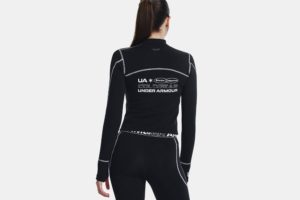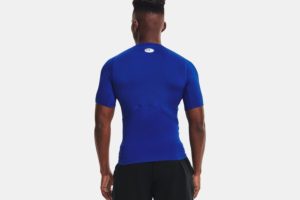Under armour rules the athletic apparel industry with a wide range of products designed to help athletes perform at their best.

Two of their most popular lines of apparel include HeatGear and ColdGear.
They’re made for use in warm and cool weather conditions, respectively. And if you’re looking for a full comparison of these two, you’re at the right place.
Below, I’ll explore the similarities and differences between UA HeatGear and ColdGear, and determine which might best fit your athletic needs.
What’s the Difference Between HeatGear vs. ColdGear?
The main difference between HeatGear and ColdGear is that HeatGear is designed to keep you cool and dry in warm weather, while ColdGear is made to keep you warm in colder temperatures.
UA HeatGear vs. ColdGear: Temperature
There’s no specific temperature range for wearing UA’s HeatGear and ColdGear.
However, HeatGear makes a great choice for warm-weather activities like running, training, and playing sports.
It’s intended to keep you cool and dry during high-intensity workouts, regardless of the temperature.
On the other hand, Under Armour’s ColdGear is made for cold weather activities and is best suited for temperatures ranging from 0 to 55 degrees Fahrenheit (-18 to 13 degrees Celsius).
However, the specific temperature range can vary depending on the individual and the intensity of the activity.
ColdGear isn’t intended for extreme cold conditions and should be layered appropriately with additional clothing for maximum warmth and protection.
UA HeatGear vs. ColdGear: Purpose
HeatGear keeps you cool and dry during warm-weather activities like running, training, and playing sports.
On the other hand, ColdGear keeps you warm during colder weather activities, such as skiing, snowboarding, and running in colder temperatures.
Moreover, Under Armour’s HeatGear isn’t designed to keep you warm.
HeatGear is intended to be used in warm weather or during activities that generate a lot of heat, such as running or playing sports.
The lightweight and breathable fabric is engineered to wick sweat away from your skin to help keep you cool and dry during high-intensity workouts.
While Under Armour’s HeatGear isn’t designed for cold weather activities, it can still be used in the winter, depending on the specific conditions and your preferences.
If you plan to exercise outdoors in cold weather, I suggest wearing appropriate clothing, such as a long-sleeve HeatGear shirt under a warmer jacket or coat.
On the other hand, Under Armour’s ColdGear is designed for cold-weather activities.
It’s made of a thicker, insulating material that traps body heat to keep you warm and comfortable during cold-weather workouts.

UA HeatGear vs. ColdGear: Material
HeatGear and ColdGear consist of different materials.
HeatGear is a lightweight, breathable fabric that wicks sweat away from your skin to keep you dry. It’s usually made of polyester or a blend of polyester and elastane.
ColdGear, on the other hand, is made of a thicker, insulating material that traps body heat to keep you warm. It’s usually made of a polyester, elastane, or nylon blend.
UA HeatGear vs. ColdGear: Thickness
HeatGear and ColdGear also differ in thickness.
HeatGear is thinner and lighter than ColdGear because it’s made of lightweight and breathable fabric to keep you cool and comfortable in hot weather.
On the other hand, ColdGear is made of thicker and more insulating fabric to keep you warm in cold weather.
UA HeatGear vs. ColdGear: Styles
HeatGear and ColdGear come in various styles, including compression shorts, leggings, t-shirts, and hoodies.
However, ColdGear also includes heavier outerwear options like jackets and vests.
UA HeatGear vs. ColdGear: Colors and Prints
HeatGear and ColdGear offer a range of color and print options, but ColdGear tends to have more subdued and darker colors, while HeatGear offers brighter and more vibrant color options.
UA HeatGear vs. ColdGear: Odor Resistance
HeatGear and ColdGear have anti-odor technology to stop the growth of odor-causing bacteria. This is especially important for wearing sweaty and smelly athletic wear over time.
UA HeatGear vs. ColdGear: Washing and Drying
As someone who has both models at home, I’ve learned a thing or two about washing and drying HeatGear and ColdGear properly.
Although washing and drying clothes seem simple, trust me, it’s not, especially when dealing with specific fabrics.
If you wash and dry your HeatGear and ColdGear wrong, you can damage the fabric.
If you own HeatGear, I suggest you avoid fabric softeners because they can clog the fabric’s pores and reduce the moisture-wicking capabilities of your apparel.
I usually wash my HeatGear in cold water on a gentle cycle with a mild detergent.
Also, I don’t wash my HeatGear with other clothes with zippers because they can easily snag the fabric and ruin everything.
As for drying, I suggest avoiding high heat. Otherwise, your HeatGear might shrink or lose shape.
Instead, hang your HeatGeat to air dry. If you’re in a hurry, put it in the dryer in a low-heat setting.
If you own ColdGear, I recommend you avoid hot water and high heat. Otherwise, you might damage the fabric, resulting in no insulation.

Instead, wash your ColdGear in cool or warm water on a gentle cycle. Also, use a mild detergent.
Lastly, I suggest air drying your ColdGear for the best results. However, if you must dry your ColdGear quickly, put it in the dryer in a low-heat setting.
Overall, both HeatGear and ColdGear aren’t high-maintenance. However, you must take proper care, which includes correct washing and drying.
In summary, avoid fabric softeners and high heat and use mild detergents and gentle cycles.
UA HeatGear vs. ColdGear: Price
The price of HeatGear and ColdGear varies depending on the style and product.
ColdGear usually costs more than HeatGear because it’s made of more insulating fabric and is thicker.
UA HeatGear vs. ColdGear: Which is Better for You?
When deciding between Under Armour’s HeatGear and ColdGear, consider the purpose and intended use of the apparel.
For example, if you live in a warmer climate or participate in activities that generate a lot of heat, such as running or playing sports, HeatGear would be a better option.
The lightweight and breathable fabric will help keep you cool and dry during workouts.
On the other hand, if you live in a colder climate or participate in cold-weather activities, such as skiing or snowboarding, then ColdGear would be a better choice.
The thicker, insulating material will help trap body heat and keep you warm during outdoor activities.
You should also consider the style and fit of the apparel. HeatGear and ColdGear come in various styles and fits to suit your needs and preferences.
Ultimately, the decision between HeatGear and ColdGear comes down to your personal preference and the apparel’s intended use.
Considering these factors, you can make a well-informed decision and choose the best option for your needs.
Key Takeaways
UA HeatGear and ColdGear offer advanced technologies to help athletes perform at their best in warm and cool weather conditions.
While both lines share some similarities, such as their moisture-wicking properties, they differ in key aspects, such as their insulation and fabric weight.
You can make a smart buy by understanding the differences between these two lines.
Whether you pick UA HeatGear or ColdGear, you can trust that you’re paying for high-quality athletic apparel to help you push past your limits and achieve your goals.

Some people collect expensive old cars, and I’m into collecting bikes. I have 15 different bikes: special mountain bikes, sportbikes, professional, amateur, and city bikes. My friends and colleagues call me a ‘bike expert’ because I give advice on how to choose the right bike.
I’m also a massive fan of gym culture and heavyweight workouts. I met Alan at my local gym, and we’ve become friends quite soon. His idea of starting a sports blog seemed interesting to me, so I agreed to help.





